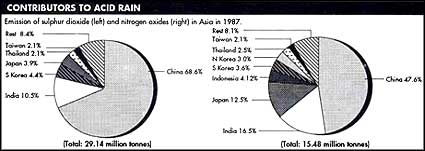Energy consumption patterns vary in Asia
 EMISSIONS of sulphur dioxide and nitrogen oxides play a key role in the formation of acid rain and consequently, the acidification of soils. Production of nitrogen oxides leads to ozone build-up in the troposphere -- the layer of the atmosphere closest to the earth -- and, in turn, affects the concentration of the hydroxyl radical (OH), which determines the life of greenhouse gases.
EMISSIONS of sulphur dioxide and nitrogen oxides play a key role in the formation of acid rain and consequently, the acidification of soils. Production of nitrogen oxides leads to ozone build-up in the troposphere -- the layer of the atmosphere closest to the earth -- and, in turn, affects the concentration of the hydroxyl radical (OH), which determines the life of greenhouse gases.
Economic activities and energy consumption are growing rapidly in Asia. But energy consumption patterns vary considerably in Asian countries -- Nepal, Cambodia, and Laos meet 90 per cent of their energy needs from biomass fuels, which emit minuscule quantities of sulphur dioxide. On the other hand, China gets nearly 70 per cent of its primary energy from coal, whose sulphur content is higher than that found in other Asian coal, such as that used in India and North Korea.
A detailed countrywise study shows that in 1987, 25 Asian countries east of Afghanistan emitted a total of 29.1 million tonnes of sulphur dioxide and 15.48 million tonnes of nitrogen oxides. Eight countries -- China, India, Japan, Indonesia, North Korea, South Korea, Thailand and Taiwan -- accounted for 92 per cent of the nitrogen oxide emissions in Asia. Only Japan was able to decrease these emissions between 1975 and 1987. As for sulphur dioxide, only six countries -- China, India, South Korea, Japan, Thailand and Taiwan -- accounted for 92 per cent of the emissions in Asia.
Related Content
- 'I don't think future generations will be very happy with our performance'
- Journey into the market-place
- Sustainability and the southern perspective
- Climate change, sustainable development and security are coming together, and Asia must drive the post-2015 global agenda and global goals
- Global sustainable development goals: Sustainability is about the use, Distribution and scarcity of natural resources - Eradicating poverty and saving the climate
